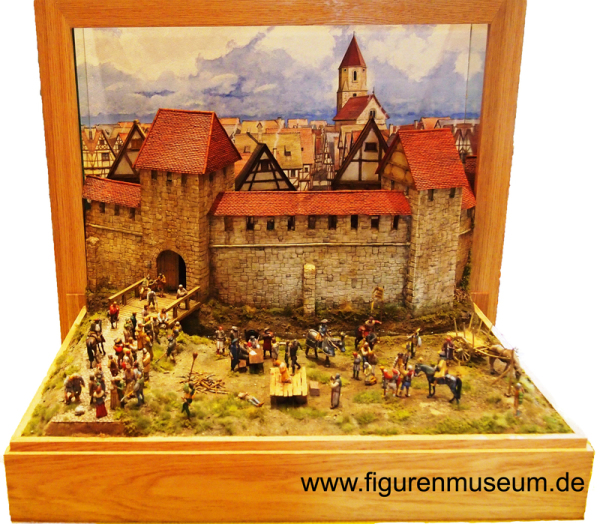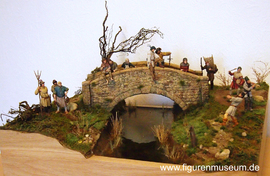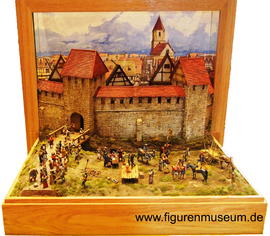
"Bauernaufstand Armer Konrad" 1514 im Schwäbischen Raum
"Die Wasserprobe" Figuren Bruecke Landschaft sind von Doug Miller modelliert. Das komplette Modell ist von Pete Watson, Sunderland/UK bemalt worden.
Hinrichtungsszene Schorndorf (oben) - Figuren sind von Doug Miller entworfen und modelliert, die Stadtmauer und Türme von Doug aus Verlindenteilen umgebaut, Stadtfassade von Doug modelliert und bemalt.
Alle Figuren der Schaustücke von Michael Burgin bemalt -der Hintergrund des Schaustückes der Hinrichtungen sind von Geoff Laws bemalt worden. Zur Vergrößerung der Dioramen klicken Sie bitte auf die Vorschaubilder!
Ausstellungen zur Bauernbewegung "Armer Konrad" 1514 im Schwäbischen - Zwei Schaustücke von Doug Miller Figures England:
Zurzeit finden vier Ausstellungen im Remstal bei Stuttgart, zur Feier der "Armer Konrad Bewegung" 1514 (armer Konrad =gebräuchlicher Name im 16. Jhd. also umgangssprachlich = Jedermann!)
Zwei Modelle zu diesen einschneidenden Ereignissen am Vorabend des "Großen Deutschen Bauernkrieges" - der auslösende Moment - die sogenannte 'Wasserprobe' in Beutelsbach (gestaltet von Doug mit Preiser Umbauten im Maßstab 1:22,5) und das Ende des Aufstandes - die Hinrichtungen der Rädelsführer (40 mm Figuren von Doug selbst modelliert) auf dem Wasen vor Schorndorf.
Falls Sie aus dem Süden sind oder Ihren Urlaub oder eine Kurzreise planen - die vier teilnehmenden Städte - Weinstadt/Beutelsbach, Fellbach, Waiblingen und Schorndorf liegen alle nah beieinander. Die Ausstellungen laufen noch bis September 2014 - dann sind die beiden Modelle von Doug in einer Dauerausstellung in Beutelsbach zu sehen. Weitere Informationen finden Sie in der Regionalen Presse u. a. in den Stuttgarter Nachrichten.
"Großer Deutscher Bauernkrieg" 1524-25 - Doug Miller Figures England
"The Peasants last stand..." ("Letzte Abwehr der Bauern")
Kleindiorama 40 mm von Doug Miller England, bemalt von Mick Burgin
During the German Peasants War a favoured tactic of the insurgents was to take up positions behind a wagonfort. Wagonforts had come into their own during the Hussite Wars almost a century earlier (for a fine example of a Hussite War wagon check out the Hausser/Elastolin model) when they were used offensively under the command of Jan Ziska. Such wagons were customised with boards for defence. In all the battles of the Peasants War, however, for example at Königshofen, Leipheim, Böblingen and Frankenhausen, the wagonforts appear to have been relatively easily penetrated by the Princes’ pikemen horse and artillery. Since they were transient affairs – many being erected in haste – all manner of objects would be placed between the wagons and carts which would have been taken from the farms and homesteads with little time for customisation into fortified warwagons. Where a peasant camp was erected opportunity arose for a more semi-permanent structure and palisades would have been erected between sections of the perimeter. In this 40mm vignette I wanted to recreate a last stand - a wounded handgunner lies on the ground behind the wooden defence, while his comrade has just been hit by a mercenary sharpshooter. Beside him the squad leader points out a way for retreat while a fourth insurgent tries to fight off the imaged Princes’ troops which his scythe.
I used a discarded round horse base for this model. The groundwork was fashioned from modelling clay and the earth from Miliput ground in a coffee grinder and sprinkled on wet cement or PVA. The palisade was made with scraps of wood – the nails are from 1:48 scale plastic bolts available from the US company Grandtline. The base is only 65mm in diameter and although I fashioned 6 figures from my own series of 40mm Peasant War figures, overall I decided to cut back on the number - it is easy to overcrowd a model like this.
The vignette is available for sale as a kit: enquiries to dougmiller.figures@virgin.net











